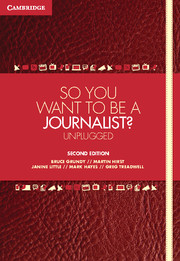Book contents
- Frontmatter
- Contents
- About the authors
- Preface to the second edition
- Acknowledgements
- Acknowledgements for the second edition
- Introduction Journalism unplugged
- Part 1 DISCOVERING JOURNALISM
- Part 2 FINDING AND UNDERSTANDING NEWS
- Part 3 NEWS-WRITING ACROSS THE GENRES
- 5 Writing news for readers
- 6 Writing broadcast news
- 7 Multimedia journalism and writing news for the web
- 8 Writing news beyond the inverted pyramid
- 9 Sub-editing
- Part 4 Legal and ethical issues
- References
- Index
7 - Multimedia journalism and writing news for the web
from Part 3 - NEWS-WRITING ACROSS THE GENRES
Published online by Cambridge University Press: 05 October 2012
- Frontmatter
- Contents
- About the authors
- Preface to the second edition
- Acknowledgements
- Acknowledgements for the second edition
- Introduction Journalism unplugged
- Part 1 DISCOVERING JOURNALISM
- Part 2 FINDING AND UNDERSTANDING NEWS
- Part 3 NEWS-WRITING ACROSS THE GENRES
- 5 Writing news for readers
- 6 Writing broadcast news
- 7 Multimedia journalism and writing news for the web
- 8 Writing news beyond the inverted pyramid
- 9 Sub-editing
- Part 4 Legal and ethical issues
- References
- Index
Summary
Chapter objectives
After reading this chapter, you should have a greater understanding of the following issues:
The similarities and differences between various news styles and formats
The relationships between text and multimedia elements in unplugged journalism
How technologies and the way we use them also shape writing and thinking about news
How writing news for the web and for online/mobile applications differs from print and broadcast writing
Why multimedia is important for online and mobile news applications
The continuing importance of the fundamentals of good and ethical reporting in online news
This chapter is about taking everything you know about journalism and news-writing and applying it to online media. It’s a racing certainty that you are familiar with the online world: the explosion of online, multimedia and mobile journalism in recent years has meant that this area of knowledge has expanded rapidly, and continues to do so. The best way to keep up is by following online debates and social media forums where these issues are being talked about. This chapter aims to introduce a newsy perspective to your online interaction.
- Type
- Chapter
- Information
- So You Want To Be A Journalist?Unplugged, pp. 161 - 173Publisher: Cambridge University PressPrint publication year: 2012

